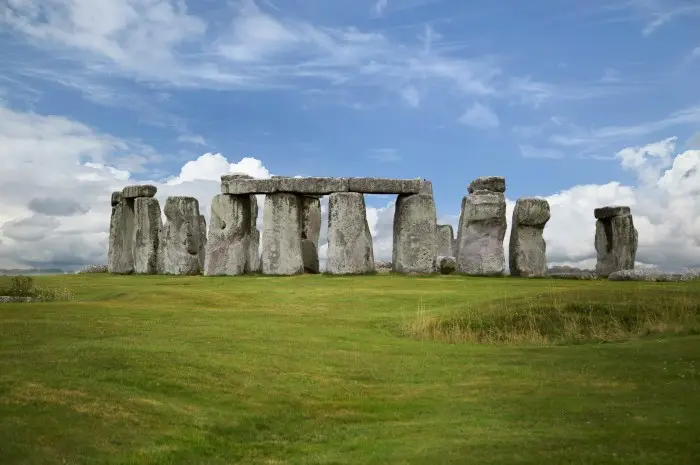Delve into the mysteries of Stonehenge, England’s prehistoric marvel, exploring its historical context, architectural significance, and the various theories surrounding its purpose and construction.
Stonehenge, located on the Salisbury Plain in Wiltshire, England, is one of the world’s most famous prehistoric monuments, dating back to around 2500 BC.
This awe-inspiring structure consists of a ring of standing stones, each around 13 feet high, seven feet wide, and weighing approximately 25 tons.
Stonehenge has captivated the imaginations of historians, archaeologists, and visitors for centuries, with its origins and purpose shrouded in mystery.
This article explores the various aspects of Stonehenge, from its construction and historical significance to the myriad theories about its original function and the ongoing research that continues to unveil its secrets.
1. Historical Context and Construction Phases
Stonehenge’s construction is believed to have occurred in several phases, starting around 3000 BC, with the original establishment of the circular earth bank and ditch enclosure.
Over the next 1500 years, it evolved through multiple stages involving the addition of the iconic sarsen stones and smaller bluestones, rearranged various times.
Radiocarbon dating suggests the stones were erected in the late Neolithic period, around 2500 BC, with later alterations in the early Bronze Age.
The construction techniques and the transportation of these stones from distances of up to 150 miles remain an impressive feat of prehistoric engineering.
2. Architectural Design and Astronomical Alignment
The architecture of Stonehenge is notable not only for its iconic trilithon horseshoe arrangement but also for its precise astronomical alignment.
The stones are positioned to frame the sunrise of the summer solstice and the sunset of the winter solstice, suggesting that the builders had a sophisticated understanding of solar movements.
This alignment supports theories that Stonehenge served as a ceremonial or religious site linked to ancient cosmology and solar worship, highlighting the builders’ ingenuity and their connection to the natural world.
3. Theories About Stonehenge’s Purpose
The purpose of Stonehenge has been a subject of speculation and debate for centuries. Early historians believed it was a Roman temple or a monument to the druids; however, modern archaeology has debunked these theories.
Today, interpretations range from an astronomical observatory to a sacred burial site. Recent discoveries of human remains in the area, showing signs of cremation before burial, support the idea that Stonehenge could have been an ancient burial ground, possibly serving as a site of pilgrimage for ancestor worship.
4. Archaeological Discoveries and Insights
Ongoing archaeological efforts continue to provide new insights into Stonehenge’s mysteries. Excavations around the site have unearthed various artifacts, including pottery, tools, and animal bones, which offer clues about the diet, lifestyle, and ceremonial practices of the people who built and used Stonehenge.
The nearby discovery of other Neolithic and Bronze Age structures, including burial mounds and similar stone circles, places Stonehenge within a broader context of prehistoric religious and cultural activity in the region.
5. Modern Scientific Techniques and Stonehenge
Advancements in technology, such as remote sensing, ground-penetrating radar, and digital mapping, have revolutionized the study of Stonehenge.
These modern scientific techniques allow archaeologists to examine the site in unprecedented detail without disturbing it.
Through these methods, researchers have identified hidden pits, new components of the landscape, and subtle details that were previously invisible, providing a fuller picture of how Stonehenge was constructed and used.
6. Cultural and Literary Significance
Beyond its archaeological intrigue, Stonehenge holds a significant place in British cultural and literary history. It has inspired countless folktales, artworks, poems, and novels, each adding layers to its mystique.
In literature, Stonehenge has been portrayed as a symbol of ancient wisdom and mystery, influencing works by authors such as Thomas Hardy and inspiring a sense of awe and reverence that transcends the academic study of the site.
7. Conservation Efforts and Challenges
Preserving Stonehenge for future generations presents unique challenges. The site faces threats from erosion, pollution, and the pressures of tourism.
Conservation efforts are continuously implemented to ensure that Stonehenge remains stable and accessible, while also preserving its integrity.
This includes managing grassland around the stones, monitoring cracks and movements within the structure, and controlling public access to prevent damage.
8. Stonehenge’s Role in Public Imagination and Tourism
Stonehenge’s iconic status makes it one of the UK’s most visited tourist attractions, drawing visitors from around the globe. Its mysterious origins and striking presence ignite the public imagination, making it a focal point for cultural tourism.
Events like the summer solstice celebrations attract thousands of spectators, who gather to witness the sunrise align perfectly with the Heel Stone, continuing ancient traditions of celebration and reverence.
9. Impact on Local and Global Heritage
Stonehenge is a cornerstone of local heritage in Wiltshire and a key part of global heritage. As a UNESCO World Heritage Site, it is recognized not only for its singular historical importance but also for its contribution to our understanding of prehistoric peoples.
Stonehenge plays a crucial role in educational programs and in promoting cultural heritage preservation worldwide, demonstrating the lasting importance of protecting our historical landmarks.
10. Future Research and Mysteries Yet Unsolved
Despite extensive study, Stonehenge still retains many secrets waiting to be uncovered. Future research, equipped with even more advanced methodologies, promises to delve deeper into its origins and uses.
Archaeologists and historians continue to decode its enduring mysteries, ensuring that Stonehenge remains a focal point of scientific inquiry and public fascination for years to come.
Stonehenge continues to be an emblem of prehistoric ingenuity and a window into the past, standing as a testament to the complex society that constructed it thousands of years ago.
Its enduring mystery and architectural grandeur ensure that it remains one of the most studied and revered landmarks in the world.
As new discoveries emerge and old theories are reevaluated, Stonehenge will undoubtedly continue to captivate and mystify, remaining a pivotal symbol of ancient human achievement.








